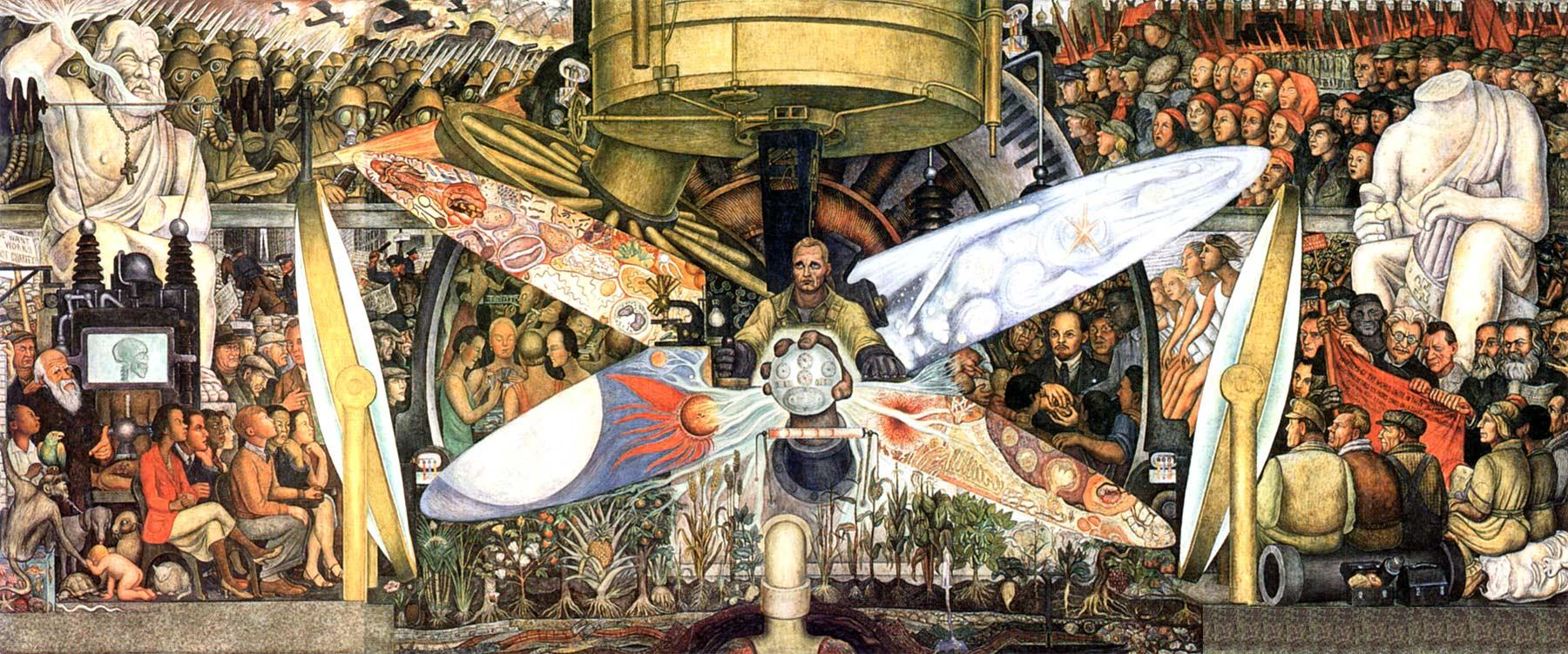
Man at the crossroads. Photo by Gumr51. Wikimedia Commons
Masterpiece: 15 Famous Mexican Paintings
Prior to the Spanish conquest in the 16th century, Mexico was part of a region known as Mesoamerica. Mesoamerican art was rich in natural elements. Political reality and the gods were also important elements in Mesoamerican art. Following the conquests of the Spanish, famous Mexican paintings used art to spread Christianity.
After Mexico gained independence in 1821, the art shifted once more. Art celebrated the heroes of independence at this time. Paintings and sculptures with indigenous themes began to appear.
The Mexican Revolution, which lasted from 1910 to 1920, had a significant impact on art as well. It radically altered Mexican culture and sparked the muralism movement. Murals conveyed patriotic, social, and political messages.
Mexico’s culture is one of the most distinct in the Western hemisphere. A closer look at the famous Mexican paintings reveals a vibrant and warm culture, as well as concepts from throughout Mexican history.
1. Echo of a Scream
David Alfaro Siqueiros is considered one of the “tres grandes” (three greats) of Mexican muralists, along with Diego Rivera and José Clemente Orozco. Siqueiros, the most radical of the three, is known for his depictions of human struggle against authoritarian regimes.
Echo of a Scream, his most famous work, depicts the bleakness, despair, and destruction of war. It is a captivating work that was painted during the Spanish Civil War and visually and metaphorically captures human suffering during war.
The painting’s most prominent figure is an enlarged head of a crying baby, with another crying baby coming out of his mouth. Shells, broken canons, and shrapnel, among other things, are scattered on the ground to depict the aftermath of war.
2. Three People
Rufino Tamayo’s best-known work is Tres Personajes, and he is widely regarded as one of the greatest Mexican painters of the twentieth century. This painting, a masterpiece of abstract art, depicts a man, a woman, and an androgynous figure. Tamayo’s signature rough surface texture was created with sand and ground marble dust mixed into the paint.
In addition, vibrant purple, orange, and yellow hues have been used to enhance the painting’s beauty. Tres Personajes was purchased for $55,000 in 1977 by a resident of Huston, Texas for his wife. The painting was stolen in 1987, but it was discovered in 2003 by a New York resident who received a $15,000 USD reward.
3. Self-Portrait:The Inn of the Dawn Horse
Leonora Carrington is perhaps the most well-known female Surrealist artist, despite the fact that renowned Mexican painter Frida Kahlo declared that she was not a Surrealist. Carrington, unlike the other Surrealists, was uninterested in Sigmund Freud’s writings.
She is better known for her haunting, autobiographical paintings that depict sorcery, metamorphosis, alchemy, and the occult. Her most acclaimed work is this self-portrait, also known as The Inn of the Dawn Horse. She painted herself posing in the foreground on a blue armchair, her hand pointing toward a female hyena. A white rocking horse appears to float behind her head, while a white horse gallops freely in the background window.
This portrait’s distorted perspective, mysterious narrative, and autobiographical symbolism may reflect the artist’s attempt to reimagine her own reality.
4. Detroit Industry Murals

Detroit Industry Murals. Photo by ashleystreet. Wikimedia Commons
Diego Rivera, considered a genius who could work in any style, including Impressionist, Post-Impressionist, Cubist, and Flemish, believed that everyone should be able to see his art, so he painted large murals on public buildings. He was commissioned in 1932 to paint twenty-seven frescoes for the Detroit Institute of Art in Mid town Detroit, Michigan, US.
Rivera painted 27 murals, the two largest of which are located on the north and south walls. They show workers at Ford Motor Company’s River Rouge Plant. Other panels depict scientific advances in fields such as medicine and technology. The Detroit Industry Murals were considered Rivera’s most successful work. The murals were designated as a National Historic Landmark in 2014.
5. The Two Frida’s
Frida Kahlo is one of Mexico’s most famous artists. The legendary Frida Kahlo painted many gripping and bizarre self-portraits. Historians regard The Two Fridas as a seminal work in Mexican art.
Her artwork reflects her passion for living passionately in real life. Her duality is vividly depicted in this painting. Many historians associate her duality with her divorce from another well-known Mexican painter, Diego Rivera.
In 1939, she finished the painting. It depicts one version of the artist dressed in a lovely and flowing white gown. It corresponds to the fashion of European women at the time. The left Frida, or European Frida, has a ripped bleeding heart. And the Mexican Frida on the right has her heart intact.
Her dilemma is reflected in the duality. She was aware that she belonged to the Mexican culture. Nonetheless, she had a strong desire to fit in with the more popular European style. Art critics consider it the most moving Mexican painting in existence because it highlights her belief in her Mexican roots.
6. The Broken Column

The Broken Column. Photo by Ambra75. Wikimedia Commons
Frida Kahlo and her friend Alex were riding in a bus when it collided with a street tram on September 17, 1925. Frida had to undergo 35 operations in her life due to the severe injuries she sustained in the accident.
Kahlo’s works frequently depict the trauma she experienced in her life, and this work is the most visible representation of her suffering. Kahlo’s body is opened up in this masterpiece, and a crumbling stone column replaces her spine, symbolizing the consequences of the accident. Nails are embedded in her face and body, and tears stream down her cheeks, but she keeps her gaze fixed on the viewer.
Frida finished The Broken Column many years after the accident, in 1944. However, she was inspired by the accident. The painting depicts a semi-naked Kahlo in a stunning white gown. The nails on her body represent the ongoing pain.
The barren landscape in the background symbolizes her inability to have children as a result of the accident.
7. The History of Mexico

Mural of Mexican History. Photo by Gary Todd. Wikimedia Commons
Diego Rivera, Frida’s former husband and partner, created this painting. Diego created this mural for a large main staircase inside Mexico City’s National Palace. His work frequently included historical scenes. He started work on the mural in 1929 and finished it six years later.
The painting depicts Mexican history from the native Aztec period to the present day. The mural’s scenes defined the country to its core.
One scene depicts the indigenous people being conquered by Christian influence and the centuries that followed under the Catholic faith. Rivera focused heavily on the country’s struggle for independence from Spain in this painting.
8. La Calavera Catrina
In 1913, Jose Guadalupe Posada created this iconic work. It depicts a simple, yet elegantly dressed female skeleton posing with a smile. The skeleton is dressed opulently. The bizarre paradox pays homage to the country’s European and foreign influences.
He wanted to use satire to highlight the relationship between Mexico and Europe. La Calavera Catrina is a well-known figure from Mexico’s Day of the Dead.
9. Man at the Crossroads
While Diego Rivera considers the Detroit murals to be his most successful work, critics point to Man at the Crossroads as his most successful.
The Rockefeller’s commissioned Diego to create this fresco for the Rockefeller Center’s ground floor wall in New York City. He did not, however, finish it. Diego refused to take down a portrait of Lenin, sparking outrage.
He recreated a nearly identical mural at Mexico City’s Palacio de Bellas Artes using his black and white photographs.
Man, Controller of the Universe, was the title given to the second mural. The piece depicts a clash between capitalism and socialism. On the left, wealthy people play cards and smoke. On the right, Lenin shakes hands with a diverse group of workers.
10. Our Lady of Guadalupe

Our Lady of Guadalupe. Photo by Marcaroni. Pixabay
According to legend, the Blessed Virgin Mary appeared to a 57-year-old peasant named Juan Diego in Mexico. He was an Aztec who became a Christian. Mary asked the peasant to construct a shrine for her on the spot. But the archbishop demanded proof. Juan Diego went back to Mary and informed her.
Mary told the peasant to climb to the top of the hill and collect flowers. He discovered Castilian roses, which were neither in season nor indigenous to the region. Mary had made a burlap-style cloak out of the flowers. She instructed him to open the cloak only when he returned to the bishop.
When the peasant did this, the flowers fell to the ground, leaving an image of Our Lady of Guadalupe on the surface of his cloak. The image is kept in Mexico City’s Minor Basilica of Our Lady of Guadalupe.
11. Self-Portrait with Thorn Necklace and Hummingbird
Frida Kahlo painted another self-portrait. She completed this one in 1940. She uses symbolism in her self-portraits to depict her physical and psychological wounds. Frida Kahlo is seen wearing a thorn necklace in this portrait. Blood is trickling from the wounds caused by the thorns. A black monkey and a black cat can be seen on the left and right sides. The hummingbird dangles from the thorn necklace freely.
Kahlo identified with Mexican indigenous culture. She used this portrait to demonstrate it. The black panther represents bad luck and death, the monkey represents evil, and the hummingbird represents freedom and love.
According to art critics, this self-portrait places her among symbols of colonialism and male repression.
12. The Persistence of Memory

Picture of a sculpture I bought from D’Argenta, its a representation of Salvador Dalí’s Persistence of Memory. Photo by Saimonsays1991. Wikimedia Commons
Dal’s masterpiece is “The Persistence of Memory.” The surrealist and dadaist dream-like elements are wrapped in an oniric atmosphere, emphasizing an oddness that matches Salvador’s character perfectly.
Salvador Dal was the most well-known surrealist artist. He was known for his eccentric personality and determination, as well as melted clocks and elephants on stilts. Dal worked in filmmaking, illustration, and photography, and he even wrote a cookbook about the famous dinner parties he hosted.
13. The Man in Flames
The Man in Flames, also known as The Man of Fire, is Orozco’s most famous Hispanic painting. It has a 36-foot diameter and represents the Greek myth of Prometheus, the God who stole fire from Olympus and gave it to humanity. This was the beginning of progress and civilization.
Zeus, however, was not pleased and chained Prometheus to a rock. An eagle would eat from his liver, which regenerated at night, every day until the end of time. It depicts the four elements and is one of 53 paintings housed in the Cabaas Museum.
Orozco, Rivera, and Siqueiros made it their mission after the Mexican Revolution to visually alphabetize the people through their colorful, detailed murals depicting Mexican historical passages glorifying the worker and rationalism.
They encouraged and inspired unity after it had been destroyed in many people’s minds. Orozco’s artwork is primarily concerned with social injustice. The majority of his famous Hispanic paintings can be found at the Instituto Cultural Cabaas in Guadalajara, Mexico.
14. The Creation of the Birds
“The Creation of the Birds” is a self-portrait by Remedios Varo, believe it or not. Or, at the very least, the vision she has when it comes time to unleash her creativity. Her hands’ abilities while making birds include science, alchemy, and magic.
Despite the fact that Remedios Varo spent the majority of her career in Mexico and was naturalized as a Mexican, she was born in Girona, Spain. Remedios was one of those artists whose imagination did not confine her to a canvas. Varo also painted masks, objects, and furniture.
15. Dream of a Sunday Afternoon at the Central Alameda

Dream of a Sunday Afternoon at the Central Alameda. Photo by Luis Alvaz. Wikimedia Commons
Many of Diego Rivera’s murals are regarded as iconic Mexican works. The “Sunday Afternoon Dream at the Central Alameda” depicts all significant Mexican figures and eras, including La Catrina and Frida Kahlo, as well as colonization, independence, imperialism, and revolution. Diego Rivera appears as a young boy running through the town square.
Planning a trip to Paris ? Get ready !
These are Amazon’s best-selling travel products that you may need for coming to Paris.
Bookstore
- The best travel book : Rick Steves – Paris 2023 – Learn more here
- Fodor’s Paris 2024 – Learn more here
Travel Gear
- Venture Pal Lightweight Backpack – Learn more here
- Samsonite Winfield 2 28″ Luggage – Learn more here
- Swig Savvy’s Stainless Steel Insulated Water Bottle – Learn more here
Check Amazon’s best-seller list for the most popular travel accessories. We sometimes read this list just to find out what new travel products people are buying.









